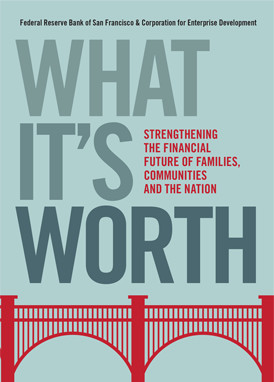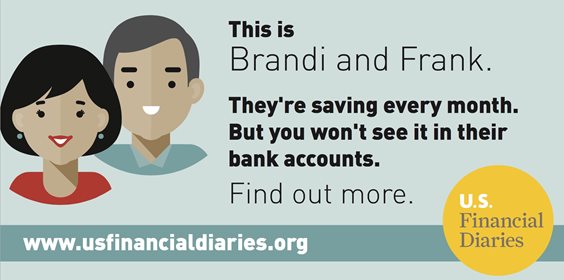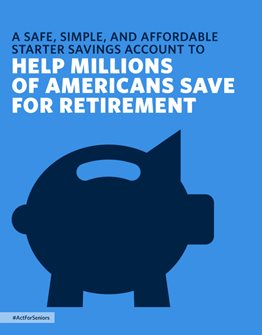The Great Recession dramatically demonstrated how extraordinarily vulnerable the majority of Americans are—not just those who already were precarious even before the housing bubble burst, but also so many others who are “keeping it together” on the surface, but are actually in danger of teetering over the edge with an unexpected provocation. 
At the level of the individual and family, the consequence of poor financial health is catastrophic. But the collective size of this malaise (70 percent of U.S. households are savings-limited, income-constrained or debt-challenged) should be downright alarming for the nation. Jared Bernstein from the Center on Budget and Policy Priorities writes in the new book, “What It’s Worth” that there is “strong evidence that inequality, income stagnation and under-regulated finance interact in ways that have led to bubbles and busts that damage the larger economy.”
That’s one reason why NeighborWorks America has chosen to focus on “creating economic opportunities” in 2016, focusing all four of its Wednesday symposia at its training institutes on different aspects of the theme. It’s also why our CEO Paul Weech contributed a chapter, and why we believe “What It’s Worth” is such an important book to read and share far and wide. (It does for financial capability what we plan to do for community development in our own book, to be released in December.)
Because it is long, and also to whet your appetite, I thought I would share my “CliffsNotes” version of a few of the suggested solutions to various aspects of the financial crisis among America’s communities and families, which will hopefully stimulate discussion and debate (and lead you to peruse the full book for more detail). Note that for purposes of this summary, I focus on those that do not involve federal or state policy changes, or modification in the way financial institutions operate. Below is the first installment, followed by two more!
Findings from the 'Diaries'
From Jennifer Tescher, Center for Financial Services Innovation, and Rachel Schneider, Center for Financial Services Innovation: “The Real Financial Lives of Americans”

Schneider is one of the coordinators of the U.S. Financial Diaries project, which was featured at NeighborWorks’ August training institute on “Building Pathways to Financial Resilience.” She and Tescher offer several key observations that are important for those offering financial education and coaching:
- Cash flow is as important an indicator as annual income. Households with seemingly sufficient income get into trouble when the timing of their expenses don’t match the inflow of funds. For families participating in the diaries project, about 60 percent of spending spikes were not accompanied by an income spike in the same month. One-quarter of expense spikes occurred when a household’s income was below its median.
- Access to financial services (facilitating bank accounts as an alternative to payday loans) is important but insufficient.
- Borrowing and saving are opposite sides of the same coin. What the authors mean by this is that the cheapest possible access to funds is not the sole determinant of why people choose to borrow vs. save, although that is the criterion traditional economists expect them to use. For example, although the use of personal savings is free, they require self-discipline to accumulate and provide the peace of mind that comes with knowing the funds are there. Thus, some people will borrow even when it doesn’t appear to make sense, just to preserve that “security blanket.” In contrast, sometimes people borrow for nonessential purchases, in return for the immediate gratification and the ability to build a credit history—despite the fact that it comes with a fee and the anxiety of a future obligation. The bottom line: When deciding when to borrow or save, people appear to take both the psychological and financial cost into account.
- Financial progress is complex, unpredictable, and often messy. Practitioners tend to look at household savings balances over time, caution the authors, and are disappointed when they don’t see steady growth. However, looking at point-in-time savings balances or expecting a constant upward trajectory misses the fact that people are indeed saving.
What is required from the professional community as a whole, they say, are agreed-upon metrics for financial health. “Building these metrics will require balancing the need for a point-in-time snapshot of families’ status with the benefits of a longer-term perspective,” they conclude. Perhaps this is a role for NeighborWorks America, which has led the field with its development of Success Measures?
Counteracting the demographics of inequality
Ray Boshara, Federal Reserve Bank of St. Louis: “The Future of Building Wealth: Can Financial Capability Overcome Demographic Destiny?”
Boshara stresses that due to the role of debt in harming families during the Great Recession, the focus should be on the broad concept of wealth (rather than on income and assets), or more precisely, family balance sheets. To get at that, he makes several specific recommendations:
-
Give greater weight to demographic factors in targeting resources. Although income has been the primary benchmark for safety net and tax benefits, his research at the St. Louis Fed suggests that age or birth year, race/ethnicity and education should play a greater role in the targeting of scarce resources. “Broad, ambitious efforts to invest in less-educated and minority families must not only continue, but be strengthened,” he writes. One of the best ways to do that, he says, is to start early:
-
 Create ways for families to save when children are young and integrate savings plans into other early interventions. “Every child should automatically receive a funded Child Development Account (CDA), ideally at birth or, at the latest, when entering kindergarten,” he writes. Because he believes it will be difficult for stand-alone CDAs to reach all economically vulnerable children, integration into other services is key. For example, a CDA might be offered to every mother who lives in an affordable rental development—a good example of “housing-plus” at work.
Create ways for families to save when children are young and integrate savings plans into other early interventions. “Every child should automatically receive a funded Child Development Account (CDA), ideally at birth or, at the latest, when entering kindergarten,” he writes. Because he believes it will be difficult for stand-alone CDAs to reach all economically vulnerable children, integration into other services is key. For example, a CDA might be offered to every mother who lives in an affordable rental development—a good example of “housing-plus” at work. -
Take a generational approach. Help parents (and other adults) build liquidity and financial assets. Many promising tactics are emerging for helping households build emergency or flexible savings accounts, including the federal government’s myRA, a low-cost, starter savings account created by the U.S. Treasury Department; tax-time savings opportunities, such as the “Refund to Savings” experiment that uses behavioral savings prompts in the TurboTax free federal edition; employer-sponsored programs such as AutoSave, which sets up automatic payroll deductions for emergency savings; and products that automatically build liquid savings as families spend or pay down consumer or mortgage debts. Some of the most promising ideas for building liquidity are found in the book “A Fragile Balance” edited by J. Michael Collins.
Just how important is birth order and marriage?
 |
| Attend the next NTI Wednesday symposium! |
Boshara has some some provocative beliefs about drivers of financial instability. “Research from the bank’s Center for Household Financial Stability suggests that three demographic drivers — one’s age or birth year, education and race-ethnicity — may not be destiny, but they do increasingly matter for building wealth and financial security,” he writes.
Education and race are well-known discriminators. But age? “Of course, older families are expected to have more wealth than younger families, but what we are observing is something deeper, even historical. To our surprise, age is the strongest predictor of balance sheet health, even after accounting for race and education,” says Boshara.
Americans in their 20s and 30s, he points out, lost the most wealth in the recession and have been the slowest to recover. The wealth of younger adults is concentrated in homeownership, which suffered greatly during the recession. Younger adults also have significant mortgage and consumer debts, few liquid assets and severe labor market challenges. But, he adds, this is not just a recession story; it is also a generational story. Among those born during the second half of the century, wealth and income have stagnated at levels below those born in the late 1930s and the 1940s.
Another driver he calls out is the decline in marriage, or rather, two-income families. “A growing number of academics on both the political left and right appear to now be coming together around concerns over declining rates of marriage and rising rates of single-parent households, especially among less-educated persons,” he writes, highlighting research showing that the larger the overall share of single parents in a community, the less likely a child will rise from the bottom income quintile to the top as an adult. To me, however, instead of calling for a societal push to preserve or promote marriage (unhappy marriages can be as toxic as poverty), the focus should be on support for single parents.
Read the second installment in this series.

